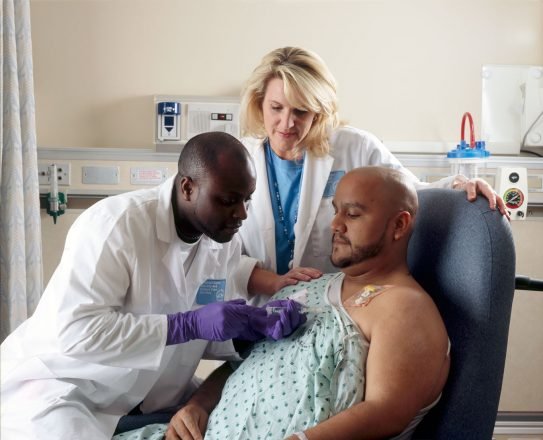Advertisment
BSH 2018: Creating off-site, nurse-led treatment units for administration of chemotherapy to people with lymphoma

The launch of biosimilar rituximab provided an opportunity to save £300,000 per year but called for time-consuming intravenous administration that exceeded the capacity of the hospital unit. Off-site treatment units seemed to be the solution…
Written by Christine Clark.
When biosimilar rituximab was launched it was significantly cheaper than the branded product and offered the possibility of saving more than £300,000 per year at University Hospital, Cardiff. However, the lymphoma unit had become accustomed to using subcutaneous rituximab and the biosimilar version was only for intravenous administration. It takes two-three hours to administer a rituximab infusion and there was not enough capacity in the day unit to accommodate all the patients. Charlotte Bloodworth (Advanced Nurse Practitioner in Lymphoma, University Hospital Cardiff) described how the team had embarked on a 60-day service improvement project to develop off-site, nurse-led treatment units to administer chemotherapy to lymphoma patients nearer to their homes.
After defining the goals of the new service and identifying the key stakeholders the team constructed a pathway map to describe every step in the lymphoma pathway. This revealed a serious bottleneck at the treatment administration stage.
Workshops with patients were organised to find out what types of services or improvements patients wanted.
Off-site facilities were identified, one of which was a district general hospital (Llandough) that had physical (chair) space but no free doctor-time. A mobile unit supplied by the charity Tenovus was used for the other site. This was an area in the north of Cardiff from which travelling can be difficult for patients.
Considerable effort was then put into training of nurses to give them the knowledge and expertise to manage some treatments without input from a doctor. Changing the working culture to one of “not needing to double check with doctors” was a critical step, explained Ms Bloodworth.
A new pathway for lymphoma chemotherapy was devised. All patients were initially assessed in hospital and first doses were given in hospital. Thereafter, patients on treatment regimens that could be given in the nurse-led clinics were allocated to a convenient off- site clinic. Patients receiving complex treatment or clinical trial medicines were not considered suitable for off-site administration of chemotherapy. Pharmacy and transport arrangements were made to ensure that the required chemotherapy doses could be compounded and delivered in a timely manner. The service was then started using continuous PDSA (plan, do, check, act) starting with a dry pharmacy and transport run and then building up the patient load. Currently there are four lymphoma patients using each off-site clinic. (Nurses in the clinics administer other types of treatment when not dealing with lymphoma treatment.)
Within 60 days one third of lymphoma patients were receiving their treatment in the off-site facilities. An audit showed that patients spent less time travelling, parking and waiting for treatment and feedback from patients was very positive.
This initiative has enabled the department to make the change to biosimilar rituximab.
There have been some organisational problems and on two occasions a nurse has decided to postpone treatment because the patient had a cold or had an obvious relapse.
In summary, Ms Bloodworth said that the changes have resulted in a sustainable service that could now grow to take on more patients, a wider range of treatments and more sites.
Based on a presentation given at the British Society of Haematology 58th Annual Scientific Meeting, Liverpool, UK.





